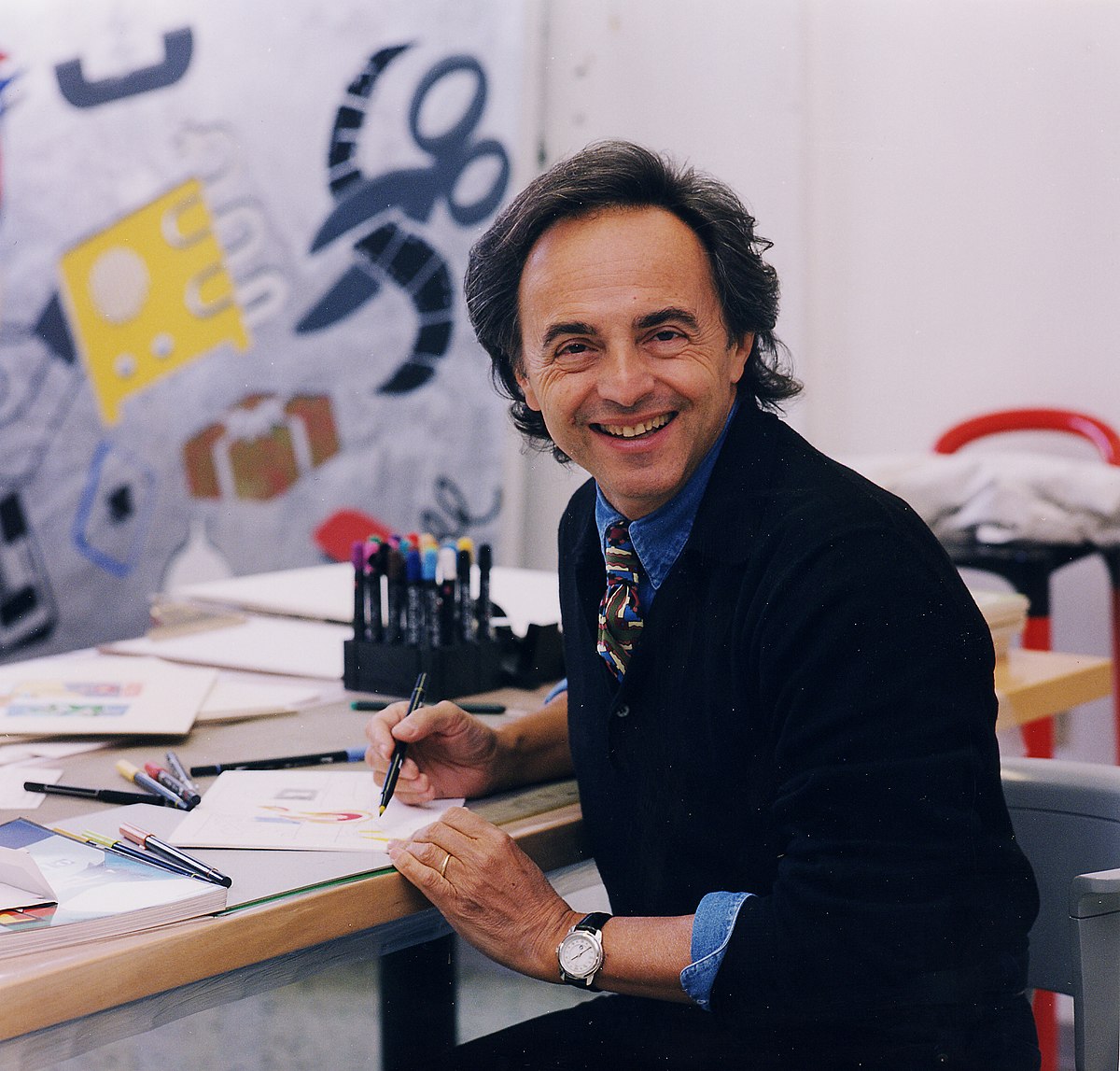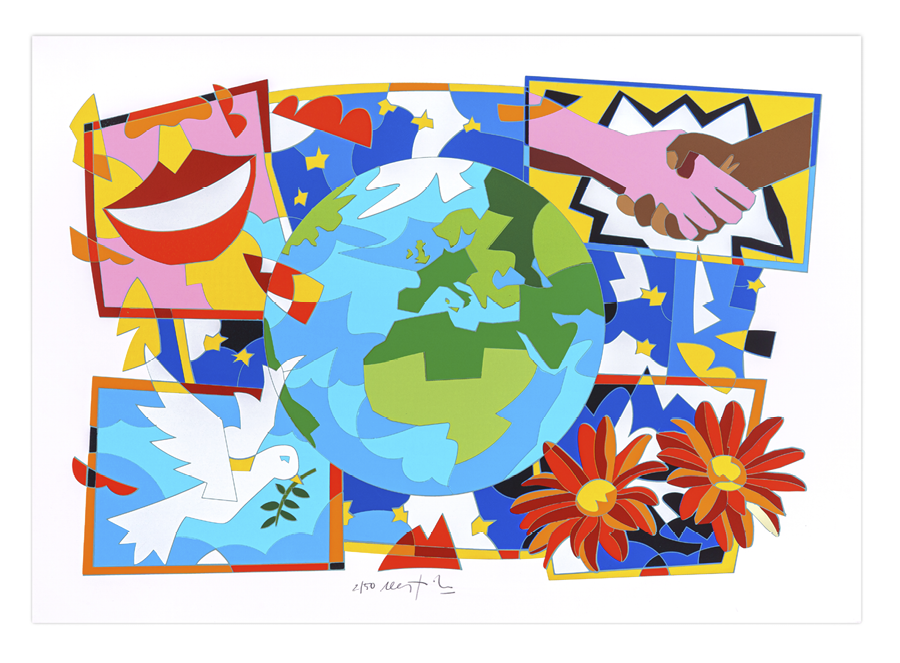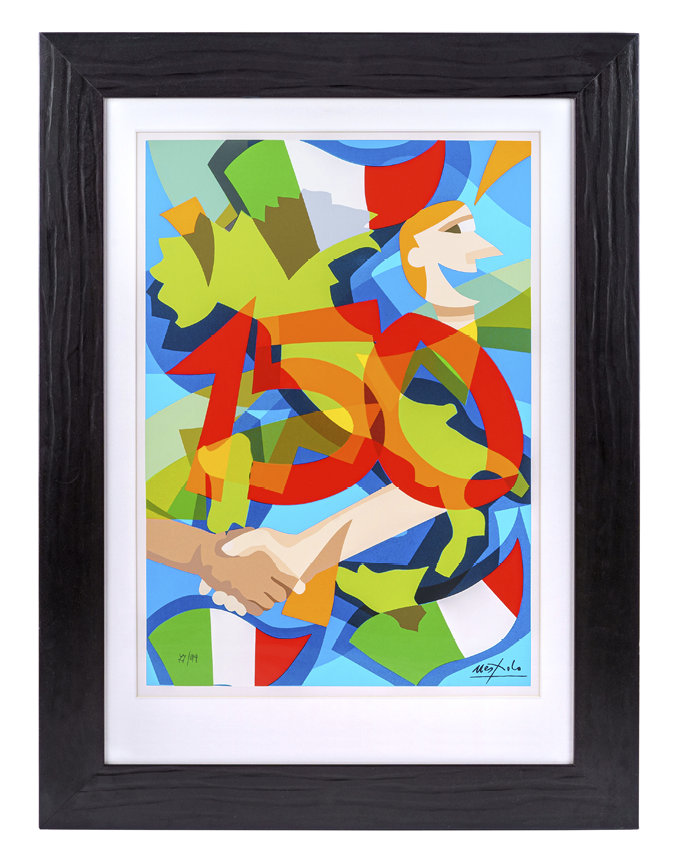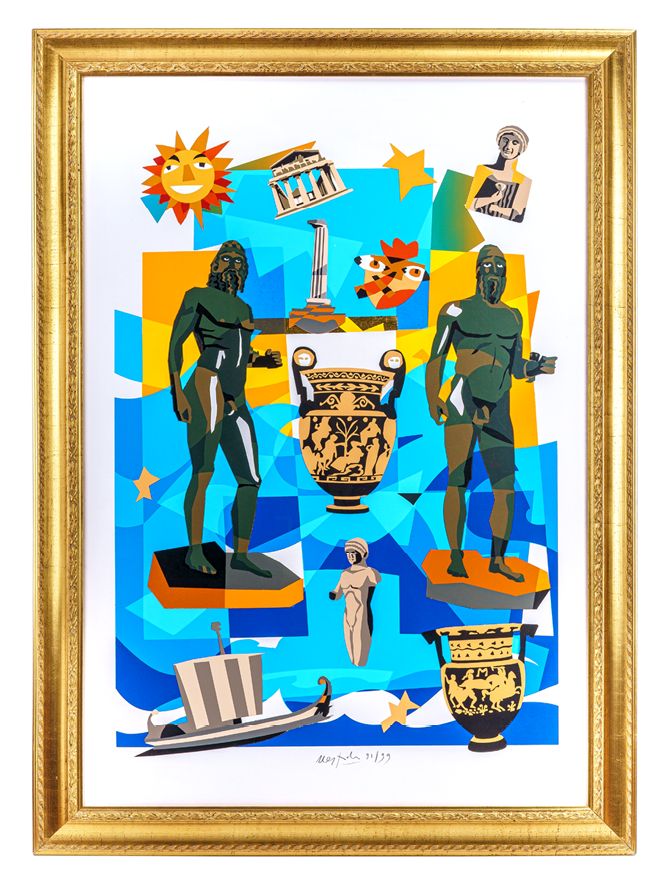
Ugo Nespolo was born in Mosso Santa Maria, in the province of Biella, into a middle-class family.
He initially graduated from the Albertina Academy of Fine Arts in Turin and later earned a degree in Modern Literature from the University of Turin. His debut in the Italian art scene dates back to the 1960s, during the Pop Art movement, and the emerging conceptual and Arte Povera movements, within the environment revolving around the new avant-gardes (exhibitions at Remo Pastori’s Il Punto Gallery in Turin and the Schwarz Gallery in Milan).
His artistic production, never exclusively tied to a single trend, has been characterized from the start by a pronounced ironic, transgressive, and playful imprint—a personal sense of amusement that has always served as his trademark. In the 1970s, Nespolo embraced a second means of expression: cinema, particularly experimental cinema. The actors were drawn from his circle of friends, including Lucio Fontana, Enrico Baj, and Michelangelo Pistoletto.
During the same period, he began experimenting with unconventional techniques (embroidery, inlay) and materials (alabaster, ebony, mother-of-pearl, ivory, porcelain, silver) as an indication of a constant inclination towards exploration and remarkable creative versatility—essential qualities for a contemporary artist. “L’albero dei cappelli” (The Hat Tree) was born during this time, later produced in series as a decorative element. The 1980s marked the core of his “American period”: Nespolo spent part of the year in the United States, and the streets, shop windows, skyscrapers, and hamburger vendors of New York became the protagonists of his paintings. During this period, he also successfully ventured into applied arts, creating about fifty posters for various exhibitions and events (including Azzurra 1983, Turin International Auto Show, National Sailing Federation 1986), the 1986 Rai calendar, stage designs for the American production (Stanford) of Busoni’s Turandot, and video intros for Rai programs (such as “Indietro Tutta” with Renzo Arbore). In 1986, the city of Genoa celebrated the twenty years of his artistic activity with a retrospective exhibition at the Civic Museum of Contemporary Art at Villa Croce, titled “La Bella Insofferenza” (The Beautiful Intolerance). In 1990, the City of Milan dedicated a significant retrospective to Nespolo at Palazzo Reale.
In the same year, Nespolo engaged in prestigious artistic collaborations, such as a advertising campaign for Campari, set designs and costumes for Paisiello’s “Don Chisciotte” for the Teatro dell’Opera di Roma, and a ceramics exhibition for his new artistic interest—within the framework of the International Biennial of Ceramics and Antiques at the Palazzo delle Esposizioni in Faenza. In 1991, Nespoli participated in the International Ceramic Festival, Ceramic World, in Shigaraki, Japan. The following year, the Borghi & C. Gallery in New York hosted a solo exhibition of his paintings and ceramics, titled “A Fine Intolerance.” In 1994, the Valle d’Aosta Region organized an exhibition of his works related to cinema at the Tour Fromage. The next year, Nespolo created the sets and costumes for Donizetti’s “L’Elisir d’Amore” for the Teatro dell’Opera di Roma, which later toured to the Opèra in Paris, Lausanne, Liege, and Metz.
In 1998, he began creating the monument “Lavorare, Lavorare, Lavorare, preferisco il rumore del mare” (Work, Work, Work, I prefer the sound of the sea) for the city of San Benedetto del Tronto, which was displayed on the waterfront. He also started a collaboration with the historic art glassworks Barovier & Toso in Murano, for which Nespolo created a series of works exhibited at the Palazzo Ducale in Venice during the “Aperto vetro. Esposizione Internazionale del Vetro Contemporaneo” event. Subsequent important solo exhibitions took place at the Palazzina Azzurra in San Benedetto del Tronto and the XVII Biennale of Contemporary Art organized by the Municipality of Alatri.
In 2000, the City of Naples dedicated a retrospective exhibition to Nespolo at the Palazzo Reale, titled “Nespolo + Napoli.” For the Jubilee Year, Nespolo illustrated a limited and numbered edition of the Apocalypse, with an introduction by Bruno Forte.
In 2002, Nespolo accepted the role of consultant and artistic coordinator for the integration of contemporary artworks into the stations of the upcoming Turin Metro. The Mandria Park in Venaria Reale hosted some of his sculptures at the Villa dei Laghi as part of the exhibition “Scultura internazionale a La Mandria.” His activities in 2003 were particularly intense: Alitalia inaugurated its new office in New York with a solo exhibition by Nespolo, followed by a traveling exhibition in Eastern European countries from May to December.
In May, he presented a solo exhibition at the Italian Cultural Institute in Paris. During the Locarno Film Festival in Switzerland, he showcased two solo exhibitions: one at the festival venue and the other at the Gallery of Modern Art. In the fall, he organized a significant solo exhibition at the National Museum of China in Beijing. In 2004, equally rich in events, he had two grand solo exhibitions: one in Vilnius, Lithuania, at the Ciurlionis National Museum of Art (January), and the other in Canton (Guangzhou), China, at the Guang Dong Museum of Art (February/March). In April, he inaugurated a solo exhibition at the Doria Palace in Loano, titled “Homo Ludens. Il gioco” (Homo Ludens. The Game).
The year 2005 began with the solo exhibition “In forma di libro” (In the Form of a Book) at the Poldi Pezzoli Museum in Milan. In the same venue, the artist’s book “32+1 per Nespolo” (Colophon Editions) was presented. The Hong Kong Cultural Centre, in collaboration with the Italian Embassy and the Municipality of Hong Kong, and with the sponsorship of the Piedmont Region, hosted a new edition of the grand solo exhibition that had previously been successful in Beijing, Canton, and Shanghai. Nespolo continued his involvement in cinema with the conception and direction of “Dentro e Fuori,” a filmed portrait of Angelo Pezzana, produced by the National Cinema Museum of Turin, under the auspices of the Piedmont Region. Recently, Nespolo illustrated a limited and numbered edition of “The Thousand and One Nights,” with an introductory text by Angelo Arioli.
Ugo Nespolo channels all the experiences acquired in his numerous other fields of work into his painting activity, creating works that are playful, rich in stimuli, and deaf to the call of perspective and composition rules. Nespolo’s silkscreens and unique works are rhapsodies of elements associated with each other according to ever-changing criteria. The viewer can get lost in the references that emerge from the sheets
MULTIPLE ARTWORKS

Mondo Armonico
LOTTO 15

Senza Titolo 23
LOTTO 23

150 anni dell’unità d’Italia
LOTTO 33

Bronzi di Riace
LOTTO 155
